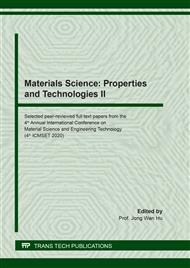p.51
p.56
p.61
p.66
p.72
p.78
p.83
p.88
p.94
Prediction of the Tensile Strength and Electrical Resistivity of Concrete with Organic Polymer and their Influence on Carbonation Using Data Science and a Machine Learning Technique
Abstract:
The inclusion of additions to concrete blends helps to improve performance in certain conditions. The analysis of two concrete blends was performed, a blend with the addition of a natural organic polymer and a control blend to make predictive models and find a correlation. Tree tests were performed: Electrical resistivity (Er) test, Tensile strength (Ft) and Carbonation resistance. One of the most popular non-destructive tests on concrete is , due to the simplicity of measuring readings on concrete elements. It is a non-destructive test that determines the interconnectivity that exists in the concrete cementitious matrix by determining the quality of the concrete. The blend with the addition showed improved performance in all the tests. Data science techniques were used to generate artificial data, the Machine Learning technique (ML) is based on Tree regression (Tr) with satisfactory accuracy to assess the reliability.
Info:
Periodical:
Pages:
72-77
Citation:
Online since:
September 2020
Keywords:
Price:
Сopyright:
© 2020 Trans Tech Publications Ltd. All Rights Reserved
Share:
Citation:


